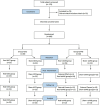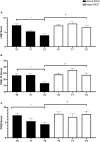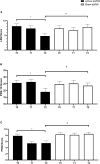Effects of multisession prefrontal cortex tDCS or taVNS on stress, perceived stress and sleep quality: a double-blind, randomized controlled study
- PMID: 39346507
- PMCID: PMC11427356
- DOI: 10.3389/fpsyg.2024.1343413
Effects of multisession prefrontal cortex tDCS or taVNS on stress, perceived stress and sleep quality: a double-blind, randomized controlled study
Abstract
Introduction: Chronic stress is a condition characterized by prolonged stimulation, leading to mental and physical weakness. It can have detrimental effects on individuals' mental health and cognitive function, potentially causing various health issues. This article explores the potential of non-invasive neuromodulation techniques, specifically transcranial direct current stimulation (tDCS) and transcutaneous auricular vagus nerve stimulation (taVNS), in managing chronic stress and improving sleep quality.
Methods: The study conducted a randomized, double-blinded, controlled trial with participants experiencing chronic stress. In total, 100 participants were randomly assigned to one of four conditions: the anodal tDCS group (n = 50), the sham tDCS group (n = 50), the taVNS group (n = 50), or the sham taVNS group (n = 50). Within each condition, participants received five sessions of either active treatment or sham treatment, with 20 min of tDCS over the dorsolateral prefrontal cortex (2 mA) for the tDCS groups, or taVNS on the left ear (20 Hz) for the taVNS groups. At baseline, post-intervention, and 4 weeks thereafter, we evaluated stress using the Lipp's Inventory of Stress Symptoms for Adults (LSSI), perceived stress through the Perceived Stress Scale (PSS-10), and sleep quality via the Pittsburgh Sleep Quality Index (PSQI).
Results: The tDCS and taVNS interventions resulted in reduced stress levels, improved sleep quality, and enhanced perception of stress.
Discussion: These findings suggest that tDCS and taVNS hold promise as effective treatments for chronic stress, offering a safe and accessible approach to improving individuals' wellbeing and overall quality of life.
Clinical trial registration: https://ensaiosclinicos.gov.br/rg/RBR-2ww2ts8, identifier UTN: U1111-1296-1810; Brazilian Registry of Clinical Trials (REBEC) RBR-2ww2ts8.
Keywords: chronic stress; neuromodulation; sleep quality; transcranial direct current stimulation; transcutaneous auricular vagus nerve stimulation.
Copyright © 2024 dos Reis, Pereira Generoso, Pereira, Teixeira Barú, Candido, Maziero Capello, de Castro, Cardoso, Scoz, Ferreira, da Silva and da Silva.
Conflict of interest statement
The authors declare that the research was conducted in the absence of any commercial or financial relationships that could be construed as a potential conflict of interest.
Figures




Similar articles
-
Transcutaneous auricular vagus nerve stimulation modulates masseter muscle activity, pain perception, and anxiety levels in university students: a double-blind, randomized, controlled clinical trial.Front Integr Neurosci. 2024 Jul 10;18:1422312. doi: 10.3389/fnint.2024.1422312. eCollection 2024. Front Integr Neurosci. 2024. PMID: 39051059 Free PMC article.
-
Assessing the Effect of Simultaneous Combining of Transcranial Direct Current Stimulation and Transcutaneous Auricular Vagus Nerve Stimulation on the Improvement of Working Memory Performance in Healthy Individuals.Front Neurosci. 2022 Jul 19;16:947236. doi: 10.3389/fnins.2022.947236. eCollection 2022. Front Neurosci. 2022. PMID: 35928012 Free PMC article.
-
Comparing the effects of multi-session anodal trans-cranial direct current stimulation of primary motor and dorsolateral prefrontal cortices on fatigue and quality of life in patients with multiple sclerosis: a double-blind, randomized, sham-controlled trial.Clin Rehabil. 2020 Aug;34(8):1103-1111. doi: 10.1177/0269215520921506. Epub 2020 May 12. Clin Rehabil. 2020. PMID: 32397748 Clinical Trial.
-
Anodal transcranial direct current stimulation associated with aerobic exercise on the functional and physical capacity of patients with heart failure with reduced ejection fraction: ELETRIC study protocol.Trials. 2023 Nov 17;24(1):738. doi: 10.1186/s13063-023-07694-2. Trials. 2023. PMID: 37974293 Free PMC article.
-
Transcutaneous Auricular Vagus Nerve Stimulation in Insomnia: A Systematic Review and Meta-Analysis.Neuromodulation. 2025 May 5:S1094-7159(25)00144-8. doi: 10.1016/j.neurom.2025.04.001. Online ahead of print. Neuromodulation. 2025. PMID: 40323248 Review.
Cited by
-
Neuroregulatory and clinical efficacy of auricular vagus nerve stimulation in elderly patients with chronic insomnia comorbid with functional dyspepsia: protocol for a randomized controlled trial.Front Med (Lausanne). 2025 Mar 18;12:1537515. doi: 10.3389/fmed.2025.1537515. eCollection 2025. Front Med (Lausanne). 2025. PMID: 40171499 Free PMC article.
References
-
- Alyan E., Saad N. M., Kamel N. (2021). Effects of workstation type on mental stress: FNIRS study. Hum. Factors 63 1230–1255. - PubMed
-
- Ancoli-Israel S., Cole R., Alessi C., Chambers M., Moorcroft W., Pollak C. P. (2003). The role of actigraphy in the study of sleep and circadian rhythms. Sleep 26 342–392. - PubMed
-
- Anunciação L., Marques L., Andrade L. D., Soares A. C. C., Cruz R. M., Lipp M. E. N. (2022). Psychometric evidence for the lipp’ adult stress symptoms inventory. Paidéia (Ribeirão Preto) 32:e3235.
LinkOut - more resources
Full Text Sources

